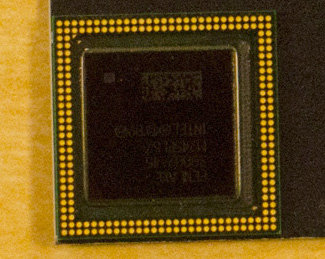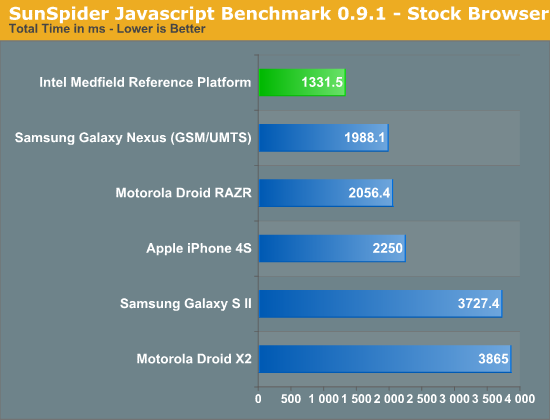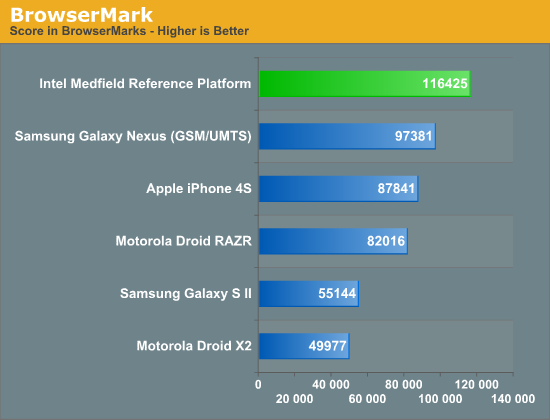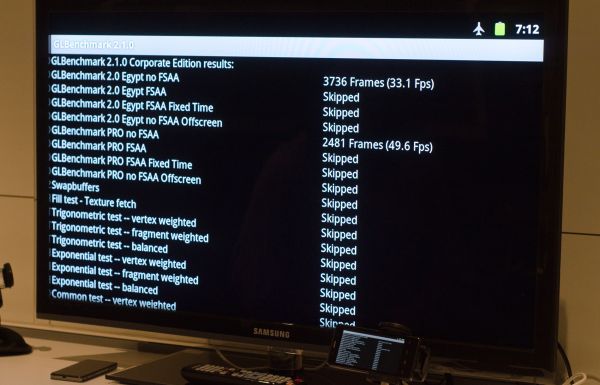Intel's Medfield & Atom Z2460 Arrive for Smartphones: It's Finally Here
by Anand Lal Shimpi on January 10, 2012 8:00 PM ESTIt's here. Intel's first smartphone SoC that you'll actually be able to buy in a device before the end of the year. The platform is called Medfield and Paul Otellini just announced its first device partners.
Medfield starts out as a bonafide mobile SoC. Whereas Moorestown was a "two-chip" solution, Medfield is just one - the Penwell SoC:

The SoC is only available in a PoP (Package on Package) configuration measuring 12mm x 12mm. Intel wouldn't give out a die size but it did show me a Penwell sample without the stacked DRAM:

Since I know the measurements of the package I could estimate the dimensions of the silicon itself. My math worked out to be around 62mm^2. That's larger than a Tegra 2-class SoC, but smaller than Tegra 3 or Apple's A5. The diagram of its high level architecture above helps explain why.
There's only a single version of Medfield being announced today: the Intel Atom Z2460. The Z2460 features a single Atom core with a 512KB L2 cache, a PowerVR SGX 540 GPU and a dual-channel LPDDR2 memory interface. In a world where talking about four Cortex A9s and PowerVR SGX 544MP2s isn't uncommon, Medfield starts out almost sounding a bit...tame. But then you see its performance:

Although running what appears to be a stock Gingerbread browser, Intel's Medfield reference platform posts SunSpider performance better than any other smartphone we've tested - including the Galaxy Nexus running Ice Cream Sandwich. Intel promises that Medfield's performance will scale on ICS as well - the gap should be maintained. We've seen high results from reference designs in the past, but the Medfield platform is a little different as you'll soon see - it's a complete smartphone design that should be representative of handsets that hit the market later this year.
Medfield isn't a one trick pony either, performance is similarly dominating under BrowserMark:

These are tablet-like scores. Here the Galaxy Nexus running ICS comes close, but once again Intel expects that on the same OS Medfield should be faster than any of the currently available SoCs.
I asked Intel where its SunSpider and BrowserMark performance advantages came from, especially considering we've typically only seen huge gains with new browsers and not new SoCs. Their response pointed to a bunch of factors, but one stand out issue was the A9 has a great execution core but seems to be more limited on the memory interface. Atom can support far more outstanding misses in L2 than the Cortex A9, which chokes bandwidth to the processor for anything not already in the L2 cache. This may be one of the reasons why we've never been able to get really high bandwidth numbers out of A9 based SoCs. It's probably safe to assume that things will be different with the Cortex A15, but for now it's little things like this that give Medfield a performance advantage.
GPU performance is understandably not as impressive. We couldn't get offscreen numbers of GLBenchmark 2.1 but we did get results at the device's native resolution (1024 x 600):
3D performance is better than the OMAP 4460 due to Medfield's 400MHz GPU clock compared to ~300MHz in most OMAP4 devices.
Performance without power considerations is meaningless, especially in the smartphone world. Luckily for Intel, Medfield seems very competitive there as well. Intel provided some power and performance data for Medfield based on its reference platform. I still haven't been able to verify any of this for myself, but I was able to see some power tests run in person on the reference platform and competitive devices.
The Intel provided values are pretty astonishing . Sub 20mW idle, sub 750mW during a call on 3G and although not pictured here, Intel's internal data suggests ~1W power consumption while browsing the web compared to ~1.3W on the iPhone 4S and Galaxy S 2. I've done my own measurements on 4S web browsing and came up with a very similar value.
| Intel Measured Smartphone Power Consumption (Identical Display Brightness) | ||||||
| Standby (3G) | Talk (3G) | Browsing (3G) | Video Playback 720p | |||
| Apple iPhone 4S | ~38mW | ~800mW | ~1.3W | ~500mW | ||
| Intel Medfield Reference | ~18mW | ~700mW | ~1.0W | ~850mW | ||
| Samsung Galaxy S II | ~19mW | ~675mW | ~1.2W | ~650mW | ||
The performance and power data both look great for Medfield. You would think that this data, assuming there's nothing fundamentally wrong, would be enough to convince a handset maker to actually give Intel a shot. You'd be right.
In addition to disclosing Medfield performance data, Intel is also announcing partnerships with both Motorola and Lenovo. The former is a broad, multi-year agreement stating that Motorola plans on creating many devices based on Intel silicon - the first of which will be a smartphone due out before the end of the year. Tablets will follow at some point as well.
Lenovo on the other hand will actually be taking and tweaking Intel's own Medfield reference platform, and releasing it in China in Q2.
All of this is exactly what Intel needed: a start.











164 Comments
View All Comments
Exophase - Tuesday, January 10, 2012 - link
... my point being that by the time others have 28nm ARM SoCs - you know, in a couple months - Intel's 22nm Atom will still be a good year off, quite contrary to your original claim.. Did I actually need to type that?It's not 1-2 quarters, and we know this because we're seeing Transformer Prime TF202 with Krait, not to mention the release of AMD's Southern Islands which is also on TSMC's 28nm process.
Of course it'll be a few months before we see Medfield phones on the market too: this article says Q2 for Chinese phones, which means 3+ months, and "by the end of the year" for something released from a decent global player. Not really uplifting schedules.
Of course Intel certainly may gain a much bigger process lead with Atom on 22nm and beyond, but your original comment was just wrong. That's all I'm saying.
Exophase - Tuesday, January 10, 2012 - link
Oh, and Intel's first step into the smartphone market was Moorestown. Just because almost no one used it doesn't mean that it wasn't an attempt and that we should congratulate Medfield as a first try.french toast - Wednesday, January 11, 2012 - link
ARM vendors will be RELEASING chips on 32nm HK and 28nm 4/months before Medfield hits anyware but China.The above tests are misleading, but desite that they are impressive as i thought they would be a lot further away than that.
Medfield = tegra 2 class, you have to remember that the above chips are clocked alot lower than 1.66ghz and they are single thread benchmarks.
regards to power consumption,as stated they are 45nm designs, when 28&32nm big_LITTLE arrives in a couple of months,with on die 4g, we are in another territory altogether.
When silvermont arrives it will fair against 28nmHK QUAD CORE KRAITS running at 2.5ghz and above....cant see Intel smashing that, but long term if they can be competitive then they may win due to resouces.
Braumin - Tuesday, January 10, 2012 - link
Yeah I always found the comments on x86 phones hillarious because of the ARM loving going on. I mean, it is an instruction set. Stop being an instruction set fanboy people.I've said from the beginning that Intel is not a company to expect to lay down. They just have way too many smart people, money, and by far the best fab in the industry to expect them not to be able to compete.
I'm no Intel fanboy (and certainly not x86 I mean who can love an instruction set) but they have been killing it in all sectors lately. Even their GPUs don't suck as bad as before.
I am impressed.
Hector2 - Wednesday, January 11, 2012 - link
even AMD doesn't whine about being at least a couple years behind Intel's process technology and that fact has hurt them big time. In the end, the consumer doesn't care "why" Intel has a strategic advantage with their technology it'll make them successful in smartphonestecknurd - Wednesday, January 11, 2012 - link
Dark_Archonis, Does not matter that the Medfield processor is based on 5 year old hardware design. ARM processors uses hardwired microcode while 80x86 processors uses software microcode. There is a difference how fast and how easy it is to design and optimize a processor with either of these ways. Intel can take a ten year old model and optimize the microcode while ARM will have to keep on designing new models in hardware to push out higher performing processors.The number one question, will the mobile industry take this processor even though software have to be rewritten. Sure Intel said that about 75% of Android apps can be used. Sure 90% of apps can be used if emulation is used. Mac users knows all to well that Rosetta slows down PowerPC software on an x86 processor because of the emulation.
Now why can Intel can fix their five year old Atom processor to be crammed into a smartphone is most of Intel's money goes into R&D. ARM does not have that money to go into R&D. If ARM did, Intel will have a very, very serious competitor even though ARM is an engine that runs on a completely different fuel. So the comparison of the Medfield processor from Intel and ARM Cortex A9 is like comparing apples to oranges.
ARM processors suits niche markets better than x86 processors. x86 processors suits a general purpose setup. This means Intel will have to be ready to make dramatic changes to Medfield to suit many different configurations. Intel's history for this type of business is poor or is not capable because of the tight control of the license. ARM succeeds in a market the requires many different changes thanks to its lighter control of the license. ARM processors are like lego blocks and x86 processors are like as-is.
stadisticado - Wednesday, January 11, 2012 - link
I know what you're saying but I really feel you're wrong on one point and need clarification on another.First, assuming Intel or x86 processors are not built with a (lego) block architecture is a fallacy that needs to stop right now. There's no reason x86 processors and SOCs can't be built this way and Penwell is the first example of this. I think you'll see Intel reusing and sharing a whole lot more IP blocks internally up and down the vertical stack because of this move into phones/tablets.
Second, its starting to get a little old always referring to ARM, especially how you do with respect to RnD. Its not ARM spending those dollars, its four or five discrete companies: Qualcomm, TI, nVidia, Samsung, etc. ARM sells licenses...it doesn't generally give a rip how many of its chips are sold unless the license fee is predicated on volume. Its up to the chip designers to compete with Intel, not ARM.
french toast - Wednesday, January 11, 2012 - link
Partly true, ARM does spend R&D of course, else there wouldn't be a Cortex/Mali reference design to buy..let alone any interconnects/future ISAstecknurd - Wednesday, January 11, 2012 - link
You did not read my comment correctly. I said that ARM processors are like legos while Intel or x86 is as-is. The problem with Intel's Medfield is Intel's business model. Their model is as-is, so companies that want to use this processor will have to add the components outside of this processor. In ARM case, the components can be added in the chip which does not take any space on the motherboard. When components are placed outside of the processor, the space that could have been a bigger battery will be taken up by additional components. The companies that will use the Medfield is smartphone and tablet brands like Lenovo and others.ARM makes the processor models while Qualcomm, TI, nVidia, Samsung, and others integrates them in their designs and with other technologies that these companies have created themselves. The companies that takes these processors and put them in their smartphones and tablets are LG, HTC, Nokia, ASUS, Samsung and others.
IMHO, ARM based smartphones and tablets will be cheaper than Intel based because there is least amount of effort for designing ARM based versions. Sure you can keep on supporting and hoping that Intel looks good in the smartphones and tablets, but the as-is business model is going to hurt Intel.
Exophase - Wednesday, January 11, 2012 - link
Only a few percent of instructions executed on Atom even use microcode at all. It's not so much that ARM CPUs use "hardwired microcode", it's more that they don't have instructions that are complex enough to merit microcode at all. There are a few that have some sequencing in the decoder, mainly the load/store multiple instructions, but their mapping is really straightforward; there isn't any real element of being able to "optimize" them in the same uarch.Most x86 instructions that are implemented as microcode on Atom are legacy instructions that made sense 30 years ago but don't today, either due to changes in software requirements (see BSD numeric instructions for a good example of this..) or changes in what is efficient to implement directly (see loop instruction). For a lot of these instructions you're better off doing it using simpler non-microcoded instructions. So Intel optimizing their microcode is worth mentioning (some of the instructions looked WAY slower than they should have been, going by Agner Fog's timings) but not really some massive competitive edge against ARM. It'll probably barely register as a change on any benchmarks. Hopefully Intel will make the optimizations available for the older Atoms too (the microcode can be soft-patched) and then you can see for yourself.